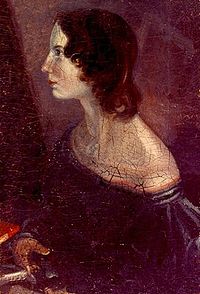Emily Bronte Biography
With wide-embracing loveThy Spirit animates eternal years,Pervades and broods above,Changes, sustains, dissolves, creates, and rears.
Emily Bronte No Coward Soul Is Mine (1848)
Short Bio Of Emily Bronte
 Emily Bronte was born 30 July 1818 in Thornton, Near Bradford in Yorkshire.
Emily Bronte was born 30 July 1818 in Thornton, Near Bradford in Yorkshire.
She was the fifth of six children, including Anne and Charlotte Bronte, who both became writers as well.
When Emily was six years old, the Bronte family moved to the village of Haworth, a village nestled in the windswept moors of West Yorkshire, which later inspired many of her writings:
Photo left – portrait by her brother.
A heaven so clear, an earth so calm,So sweet, so soft, so hushed an air;And, deepening still the dreamlike charm,Wild moor-sheep feeding everywhere.
Emily Bronte, A Little While, a Little While (1846) Stanza vii.
Her father was made the local curate of Haworth and the family lived there for the remainder of their lives. The old vicarage is now a museum dedicated to the Brontes.
Shortly after moving to Howarth, Emily’s mother passed away. The girls were then sent to the Clergy Daughters’ school at Cowen Bridge. In the aftermath of her mother’s passing, this was a traumatic experience as the sisters found the school harsh and unsympathetic. This school experience was incorporated into Charlotte Bronte’s Jane Eyre.
During a typhus epidemic, Emily lost two of her sisters (Maria and Elizabeth) to the illness; shortly afterwards Emily returned home where she was educated by her father and aunt. For a brief period, when she was 17, Emily went to Roe Head girl’s school where Charlotte was a teacher. But, due to homesickness she soon returned home.
The sisters hoped one day to set up their own school, though this never materialised. But, to gain experience, Emily became a teacher in Halifax in September 1838. However, she struggled to cope with the exhausting hours, and after a few months returned to Haworth. Apart from a brief stay in a girls academy in Belgium, Emily spent most of her later life in Haworth, where she concentrated on domestic tasks looking after her brother and family. Like her father she seems to have preferred a quiet, reclusive life. As a character in her novel writes:
“I’m now quite cured of seeking pleasure in society, be it country or town. A sensible man ought to find sufficient company in himself.”
Mr. Lockwood (Ch. III) – Wuthering Heights (1847)
This certainly applied to her father, who was quite reclusive and liked to dine alone in his room. Domestic life for Emily, was undoubtedly made difficult by her brother, Branwell who suffered from mood swings, influenced by his alcohol and drug addictions. Branwell died in 1848, shortly before Emily.
From an early age, Emily began writing displaying a vivid imagination. Her early writings were in collaboration with her sisters and brothers about an imaginary world (Gondal saga). Only small fragments remain from this period. She continued writing throughout her life, though it became an increasingly private affair; initially she disliked the idea of her poems being published though she was persuaded on finding her sisters had been writing similar poems.
In 1846, the three Bronte sisters published a collection of poems under the pseudonyms Currer Bell (Charlotte), Ellis Bell (Emily) and Acton Bell (Anne). The fact they chose masculine names suggests they wanted to avoid the prejudgment of female writers. At the time, it was rare for women writers to be published.
In 1847, she published her only novel Wuthering Heights. Based on the windswept moors of Haworth, it is a powerful tale of love, hate, sorrow and death; it
later became a classic of English literature. Though at the time, its innovative structure and complexity led to mixed reviews. In 1850, her sister Charlotte republished the book under Emily’s real name.
Frail throughout her life, Emily fell seriously sick in the autumn of 1848. Her health was undoubtedly harmed by unsanitary water which drained from the nearby churchyard. Shortly after her brother’s funeral she caught a serious cold, and refusing medical help, she died on 19 December 1848.
Emily Bronte left little writings about herself. Often, her poems and novel have been scrutinised for autobiographical hints. However, it is difficult to fully ascertain which poems are just imagination and which relate to part of her character. Her writings have been included in the broad period of romanticism. They range from stark reminders of the harshness of life, to the potential beauty and power of love and a mystical power of nature.
‘Twas grief enough to think mankindAll hollow servile insincereBut worse to trust to my own mindAnd find the same corruption there
Emily Bronte – I Am the Only Being (1836)
Then dawns the Invisible; the Unseen its truth reveals;My outward sense is gone, my inward essence feels —Its wings are almost free, its home, its harbour found;Measuring the gulf, it stoops and dares the final bound —
Emily Bronte – The Prisoner (October 1845)
- Emily Bronte at Amazon.co.uk
- Emily Bronte at Amazon.com
- Biographies of writers
- Poet Biographies
- Romantic Poets
- Inspirational Women
- Emily Bronte at Haworth Village
- Who Were the Brontes? at Bronte Museum
- Emily Bronte – Online Literature



No comments:
Post a Comment